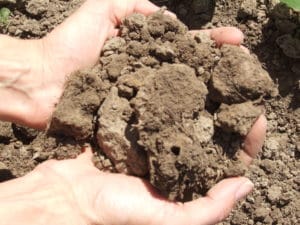By Gary Zimmer
Minerals and their respective roles in achieving healthy soil is a common topic of discussion among agriculture consultants and farmers. A long time ago, when I was going through my initial soil balance training, mineral balance was all that we talked about. Get the minerals right, address calcium and get it to 68 percent base saturation and all will be great.
The physical and biological aspects of soil weren’t even part of the discussion. Even alternate mineral sources were just touched on. Potassium chloride (KCl) was a no-no due to the high salt index and the chloride, as was dolomitic lime due to our already high magnesium soils. Also on this “not to be used” list was anhydrous ammonia because of its damaging effects on soils. The concept of soil correctives and crop fertilizers wasn’t talked about either, nor was the idea of different calcium sources for different soil conditions. The balance of nutrients on a soil test was the only goal.
Now, looking back, I can certainly see that wasn’t the whole picture. What about the biology and the physical structure? How about making a fertilizer that not only delivered soil minerals but did so more efficiently? Why not have fertilizer that can balance the soluble to the slow release, make sure carbon is added for the buffering effect and provides something for the minerals to attach to so that it is “soil biology food”? Soil health is the capacity to function without intervention; therefore minerals are certainly a part, but not the whole of soil health.
This article is about the minerals’ role in achieving the goal of soil health.
Minerals: The Big Four

Healthy, well-mineralized soils have good aggregation.
I always talk about my “Big Four” minerals: calcium, phosphorus, magnesium and boron. The Big Four relate to the plant, to the four minerals I like to get at real high levels in a plant compared to normal recommended levels.
Mineral 1: Calcium
Start by adding calcium. In most cases, just having the soil calcium level at some magic number, say 68 percent base saturation, does not guarantee the plant is able to take up sufficient levels of this mineral. The other cations in the soil, K and Mg, have an influence, and the soil’s physical properties also affect this. I know I was taught to get the calcium to magnesium ratio right and the physical structure of the soil will be great. It is true this helps, but it is not the whole picture. If the plant, let’s say it’s an alfalfa crop, on average is 1.5 percent calcium and your crop is 2 percent, something more is at work there. Generally, we have had to add some ‘soluble’ calcium along with boron to get more calcium into the plant.
Remember, not all sources of calcium are the same. Using gypsum, mixing acid materials such as humates with fine ground limestone, burning limestone and hydrating it to make hydrated lime — all alter solubility, in effect making fertilizer out of lime.
After all, soil health is ideally measured as plant health, and plant health affects the health of whoever eats that plant. So it is fair to say that the real measure of a healthy soil is a healthy crop: a high yielding, disease- and insect-free crop. Remember, you can have soil that seems great (lots of earthworms, loose and crumbly texture with a great “root cellar” smell) and yet it doesn’t produce healthy crops.
So how do you get that healthy soil? Step one is to have enough available calcium.
Mineral 2: Phosphorus
Step two is to address phosphorus. Phosphorus is tied to energy production and cycling — get the P level high and you will have a higher yielding, healthier crop. I will use potatoes as an example.

Potato growers know that the higher the petiole P level, the better the crop. Measuring the petiole and staying above 0.2 percent phosphorus is a challenge. You can apply all the soluble P the plants can tolerate and still not drive that number higher. Some growers have seen levels of 0.45 percent in the petiole on the same crop, same varieties, same locations. Why does that happen? Phosphorus is an indicator mineral because you can’t buy it in, there is a biological link required — soil life such as mycorrizhae need to be there and working in order to get more P into the plant. Just having a soil that tests high in phosphorus doesn’t guarantee high P uptake. I do like to see higher soil P levels, but there is more to getting it in the plant than just high soil test numbers.
Mineral 3: Magnesium
Step three, or mineral indicator number three, is magnesium. Many farmers and scientists already know that having soils with high magnesium levels does not guarantee high levels of the mineral in plants. If the plant takes up lots of magnesium, something ‘balanced’ is happening. Magnesium is another mark of healthy plants. It is needed for photosynthesis and is also a real indicator of proper potassium levels and distribution. (Don’t forget, sulfur is also required to achieve high magnesium exchangeability. Apply sulfate sulfur to make magnesium sulfate, a much more soluble, plant usable form than magnesium carbonate from lime.)
If extra soluble potassium is added, the plant magnesium level will drop. You can’t have both high or excess plant potassium and high magnesium. It just can’t happen! Magnesium and potassium are both cations, and compete with each other for uptake into the plant. It may be that the excess K level is more damaging than the shortage of Mg. And usually with high K, plant levels of calcium are also short.
Mineral 4: Boron
The fourth mineral as indicator is boron. Other trace minerals are also important, but boron being an anion is hard to build up and hold in the soil. It is also critical for calcium uptake and sugar translocation. Apply boron with your calcium source, and you’ll get more calcium uptake than if you apply calcium without any boron.
About Gary Zimmer
Gary Zimmer is the co-author of Advancing Biological Farming, a sequel to his earlier book, The Biological Farmer, both published by Acres U.S.A. He is also an organic dairy farmer, an accomplished speaker, and sought-after farm consultant.
Editor’s Note: This article was originally published in the October 2012 issue of Acres U.S.A.

